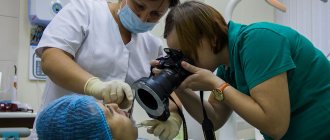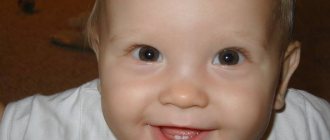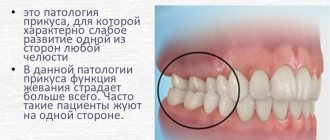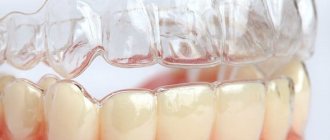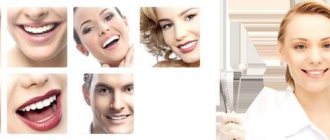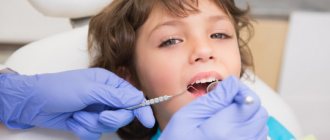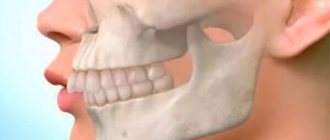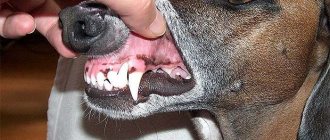Did you know that every second child has an incorrect bite? If teeth are positioned unevenly, in the future this can result in problems such as violation of facial proportions, abrasion of enamel, and pain in the jaw joint.
Perhaps your child also has dental problems? To understand this, you should consult a pediatric orthodontist.
Bite problems during teething
Bite is the closure of the teeth of the upper and lower jaw. There are correct (physiological) and incorrect (abnormal) bites. Children also have occlusion of milk teeth (from 6 months to 7 years) and permanent teeth (fully formed until 13-15 years).
Types of dental anomalies in children:
- Mesial overbite – the lower jaw is excessively pushed forward.
- Distal overbite – the upper teeth protrude strongly forward.
- Crossed - dental arches are shifted relative to each other.
- Deep - the upper incisors completely overlap the lower ones.
- Open – some teeth in the upper and lower jaws do not contact each other.
Signs by which parents can recognize improper teeth closure in their child:
- the presence of large interdental gaps;
- crowding of the front teeth, it looks as if they do not have enough space in the jaw;
- baby’s complaints of frequent headaches and discomfort when chewing food;
- bruxism (night grinding of teeth);
- speech therapy problems (speech impairment).
Types of retention devices
- removable devices: mouth guards, plate devices, double-jaw removable plate structures;
- fixed structures: wire lingual retainers (located on the inside of the teeth).
When faced with the problem of malocclusion in a child, parents should not postpone a visit to a pediatric orthodontist. The child’s dentofacial apparatus is constantly developing in the direction that nature has given it, and the sooner treatment begins, the less likely it is that the child will encounter physiological and psychological problems.
Before installing an orthodontic structure, sanitation of the oral cavity and sometimes consultation with a dental surgeon are often required.
Kuntsevo professionals have been successfully treating malocclusion in children of different age groups for many years. We practice an individual approach to each child. The choice of design and duration of its use is carried out taking into account all the needs of the child and his anatomical features. Coordination of orthodontic treatment with a speech therapist and ENT specialist is an additional guarantee not only of high-quality work performed, but also a guarantee of the child’s good general health.
Causes of dental growth abnormalities in children
Specialists in pediatric orthodontics believe that in 50% of all cases, the cause of malocclusion is heredity. After all, the child takes over from his parents the size and shape of his teeth and the structure of his jaw.
Other possible causes of abnormal bite development:
- artificial feeding (breast sucking promotes normal jaw growth);
- long-term use of pacifiers (more than 6 hours a day);
- premature loss of a baby tooth, for example, due to caries or pulpitis;
- mouth breathing;
- chronic diseases of the ENT organs;
- bad habits, such as thumb sucking;
- incorrect position of the head during sleep (throwing the head back or, conversely, pressing it to the shoulders).
Methods of orthodontic treatment for children
In pediatric orthodontics, removable and non-removable structures are used for the treatment and prevention of dental anomalies.
Removable devices
Suitable for children from 3 to 12-13 years old. These are dental plates made of high-quality plastic and silicone trainers. They can be worn at night or permanently (removed only when eating). Such structures are made in a dental laboratory individually for each child.
The main purpose of removable appliances is to activate the growth of the lower or upper jaw, expand the dental arch and prevent anomalies during the period of replacement of milk teeth with permanent ones.
Cost – from 10,000 rubles.
Fixed orthodontic appliances
Used at the age of 13-14 years. These are well-known braces; they can be metal, plastic, ceramic or sapphire (transparent). The bracket system is a universal device in pediatric orthodontics; it is effective for correcting any deformities.
Price – from 30,000 rubles. (for 1 jaw).
Children's metal braces
Orthodontic services for children under compulsory medical insurance
The children's department begins operating on August 1, 2020.
We provide free services of a children's orthodontist in Moscow under the compulsory medical insurance policy. We will correct any defect quickly and without complications. The best way to treat malocclusion is in children under 5 years of age, but thanks to experienced specialists and the use of modern technologies, we are ready to cope with dental problems in children of all ages.
Consequences of malocclusion
The sooner parents start correcting their children’s bite, the easier this problem can be solved. Malocclusion negatively affects speech formation, the respiratory and digestive systems. Experts have found a connection between improperly positioned teeth and pain in the spine, neck and head.
Bite correction in children is necessary to get rid of problems such as:
- Heavy stress on teeth when eating solid foods.
- Injury to gums and other soft tissues of the oral cavity.
- Load on the gastrointestinal tract due to poorly chewed food.
- Difficulty in proper oral care.
- Increased risk of developing ENT diseases in adulthood.
- Increased enamel wear and tooth decay.
The offices of pediatric orthodontists at the NAVA clinic are equipped with modern equipment. The technologies used by our specialists allow us to solve the problem almost painlessly. We use special mouthguards to correct bites in children. They are made for each specific patient. Using this design, the tooth position is corrected gradually, without causing discomfort to the patient. Unlike braces, aligners are removable and allow you to carefully care for your teeth.
Advantages of making an appointment with a pediatric orthodontist at the NAVA dental clinic
Most of the services in our clinic are provided under the compulsory medical insurance policy. Additionally, we can perform dental plate repairs and other procedures. Our dental specialists have extensive experience working with children. We will find an approach to every young patient.
The advantages of visiting the NAVA clinic are:
- Availability of modern European equipment.
- Painless treatment for most oral problems.
- Comfortable atmosphere for the youngest patients.
We not only perform dental correction, but also provide dental prosthetics for children. Remember that advanced disease is more difficult to cure. Regular visits to the dental office are the best way to prevent oral diseases.
Incorrect bite and other oral problems can be solved free of charge at the NAVA dental clinic in Moscow. Experienced orthodontists will help your children achieve a beautiful smile and reduce the risk of developing body problems. You can make an appointment at our clinic by calling: +7 (495) 256-29-19.
We are waiting for you and your child for a consultation!
Diagnosis of occlusion disorders
Orthodontics for children uses the same diagnostic methods as for adult patients:
- panoramic photo of both jaws;
- photographs of the face in front and profile;
- taking dental impressions - carried out using a special spoon filled with a paste-like mass;
- making plaster models of jaws based on these casts.
Having collected all the diagnostic data, the doctor will be able to determine the type of bite, plan treatment and select the most effective therapy.
Diagnostic dental impressions
Features of pediatric orthodontics
Orthodontics for children solves many health and aesthetic problems, and also eliminates the consequences of bad habits. This is especially true if the baby breathes through his mouth or positions his tongue incorrectly when speaking.
It is important for parents to understand: the sooner you take your child to a specialist, the easier and cheaper it will be to straighten teeth. At an early age (up to 14-15 years), active growth of the jaw bones occurs. Therefore, during this period, much less effort is required to put each tooth in its “right” place.
Teeth straightening plate
If your child is already 3 years old, it is recommended to take him to his first consultation. The doctor's appointment is absolutely painless, and children tolerate the examination in the orthodontist's office well.
If you are looking for a good pediatric orthodontist, then we suggest looking at the list of specialists compiled on our website.
What does an orthodontist do, how and with what does he treat?
After diagnosing the general condition of the child’s oral cavity, the orthodontist draws up an individual plan aimed at eliminating existing problems. Orthodontics for children offers several ways to correct malocclusion.
- Myotherapy is the most effective option for straightening teeth at an early age. The formation of the so-called temporary bite in children is observed in the period from 3 to 5 years. The pediatric procedure for correcting oral defects includes a set of exercises for the lips and tongue, which promote the correct and harmonious development of important muscles. This category includes receptors responsible for facial expressions and chewing processes. The effectiveness of this method lies in daily training under adult supervision. The pediatric orthodontist may also suggest using additional devices: mouthguards, plates or trainers. Modern dentistry will create all the conditions for a comfortable course of bite correction.
- Orthodontic plates are actively used by dentists to correct bites from the age of 6 years. These systems are a metal structure with an arc, hooks and springs. Such removable devices are made individually for each child after preliminary impressions are taken. These structures are worn daily, removing them only in certain cases, for example, when eating or brushing teeth. The children's plate will quickly return the correct shape to the dentition. Some guys are embarrassed to wear iron devices. In this case, the orthodontist offers unique models that have an attractive design. Multi-colored plates with images of animals or favorite characters will definitely attract the attention of children and help overcome embarrassment.
- Every orthodontist will tell you that mouth guards can be worn at any age. Possessing excellent aesthetic qualities, they are ideal for straightening teeth in children and adults. Transparent onlays are made from hypoallergenic dental materials, providing safety and comfort. The aligners are worn throughout the day, only being removed before brushing your teeth and eating.
- Braces belong to the category of non-removable devices that allow you to correct dental defects even in very severe cases. Orthodontic practice involves the use of these systems after the formation of the molar bite in a child aged 11 to 12 years. Unlike other designs, any brace system is tightly fixed to the enamel, exerting the necessary pressure on the bone and thereby causing the teeth to move in the desired direction. Modern dentistry has a variety of orthodontic equipment in its arsenal: metal, sapphire, plastic, ceramic and lingual braces. The most popular, according to many pediatric doctors, among schoolchildren are bright colored braces, which help overcome self-doubt during the entire period of treatment.
Modern pediatric orthodontics offers a wide range of devices that will help make a child’s bite correct and healthy. It is important to realize that incorrect positioning of teeth affects not only physical abnormalities, but also the psychological state of the baby. Therefore, any good orthodontist will advise starting treatment as soon as possible.
Early diagnosis will help avoid the development of severe pathologies during the formation of the child’s dental system. For psychological comfort, almost any dentistry these days opens special orthodontic rooms for children.
A child’s correct bite is the key to his health and future beauty. In conclusion, we invite you to watch an interesting video in which a qualified dentist gives valuable advice regarding the development of the dental system in children.
